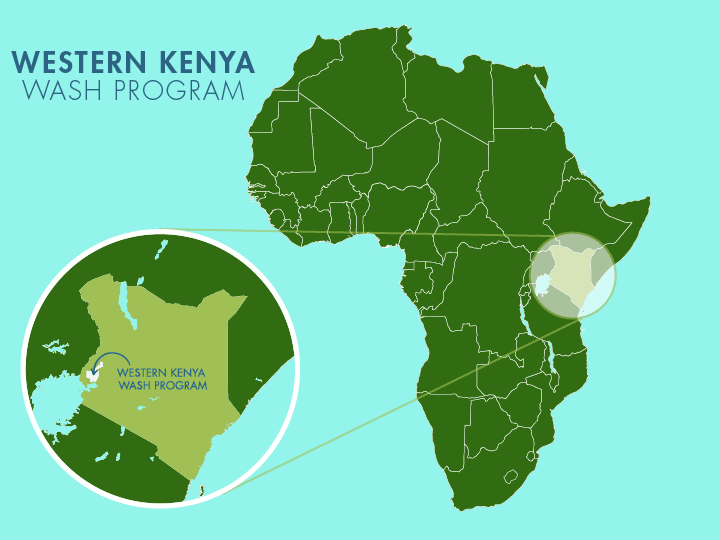Thirteen-year-old Ibrahim lives in the Imbiakalo Community, where fetching water is a daily task. Like the other 210 residents, he helps his family collect water from nearby sources — the Lusumbeya Spring, surface water, or rainwater collection when it’s available. The trips are long and tiring.

Ibrahim.
The spring was once a reliable source, but it has fallen into disrepair. Its walls are cracked, the stairs are slippery, and parts of the structure have collapsed, making it dangerous to access. When the spring runs dry, families like Ibrahim’s are forced to collect water from open, swampy areas where the water is cloudy and unsafe.

The broken-down spring.
Despite these challenges, Ibrahim has found some relief through a borehole at his school. He knows that the water there is much safer than what his family drinks at home.
“Believe it or not, but nowadays I collect drinking water from the borehole at my school because I no longer trust the quality of the water at the spring. A few years ago, it was vice versa. The only reason I don't get sick more often, like the rest of my family members, is because of the borehole at my school. I usually come home with my own drinking water, [which I have] fetched from the school well. However, that doesn't mean I haven't been sick. This year alone, I've been sick twice after forgetting to carry water from school," recalled Ibrahim.

Ibrahim hauls heavy water.
One of those times was especially difficult for him.
“Last term, I fell ill, and when my mom took me to the hospital with [an] acute stomachache, the lab test results showed I had contracted typhoid. I couldn't sleep well due to the pain in my stomach," he said.
When he first fell ill, his mother believed something else was to blame.
“In my community, there is a common belief that children don't just fall sick without someone else having a hand in it. When I got sick, my mom's first reaction was that I had been bewitched! Automatically, she knew only a traditional remedy would work. However, after noticing her herbal solution wasn't working, she rushed me to [the] hospital for proper treatment," Ibrahim continued.
The illness kept Ibrahim away from school for a week, making it difficult for him to keep up with his classmates.
“When I contracted typhoid, my body was too weak, and the stomach pain was so severe [that] I couldn't go to school for a whole week. I had to put in extra hours after official school time in order to catch up with the rest of the class," he said.
Even when he’s not sick, fetching water still affects his time at school and his grades.
“I really don't like fetching water on school days because sometimes it leads to missed lessons, and that affects my grades," said Ibrahim.

A long queue at the spring.
Like many children, Ibrahim often has to wait his turn at the waterpoint, which makes the process even longer.
“Fetching water is just one of many household chores that I have to help my family with. However, sometimes I hate it because I have to let anyone who is older than me collect water first. That results in wastage of time," Ibrahim lamented.
Even with these struggles, Ibrahim remains hopeful about his future. His experiences with illness have strengthened his resolve to help others.
“I'd love to graduate from high school and pursue a career in the medical field. My dream is to become [a] doctor so that I can treat members of my family, community, and countrymen," Ibrahim declared.
Ibrahim’s story reflects the harsh reality faced by many children in his community. Unsafe water has led to sickness, missed school, and fear, but it has also inspired his dream to become someone who can bring healing. With access to clean, reliable water, children like Ibrahim can stay healthy, attend school consistently, and work toward a future where no one has to suffer from the simple act of drinking water.
Steps Toward a Solution
Our technical experts worked with the local community to identify the most effective solution to their water crisis. They decided to safeguard the existing flowing spring.
Spring Protection
Springs are natural water sources that originate from deep underground. As water travels through various layers of the earth, it undergoes a natural filtration process, making it cleaner and safer to drink. To protect these spring sources from contamination, we construct a waterproof cement structure around layers of clay, stone, and soil. This design channels the spring water through a discharge pipe, facilitating easier, faster, and cleaner water collection.
Chlorine Dispenser
As an extra measure towards water quality safety, uniquely engineered chlorine dispensers are installed at all of our spring protection projects so community members can treat their water with pre-measured doses of chlorine. The chlorine treats any possible contamination and stays active for two to three days, ensuring water stays safe to use even when stored at home. Chlorine delivery and maintenance of the dispensers are part of our ongoing community support.
Community Education & Ownership
Hygiene and sanitation training are integral to our water projects. Training is tailored to each community's specific needs and includes key topics such as proper water handling, improved hygiene practices, disease transmission prevention, and care of the new water point. Safe water and improved hygiene habits foster a healthier future for everyone in the community. Encouraged and supported by the guidance of our team, a water user committee representative of the community's diverse members assumes responsibility for maintaining the water point, often gathering fees to ensure its upkeep.

 Protected Spring
Protected Spring
 Rehabilitation Project
Rehabilitation Project
















